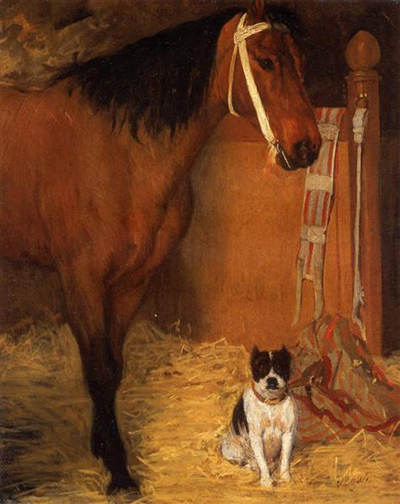The masterful 19th century French artist Edgar Degas brilliantly incorporates Impressionism within all of his work.
The beautiful piece showcases a different style of Degas that viewers have not commonly seen. Degas was transcended with portraying ballerinas and women throughout his work. The artist was seized by the stunning characteristics these women portrayed and the melodic movement of their bodies. Some of the artist's most famous pieces include Ballerinas Adjusting Their Dresses, Dancers In Pink, and Dancer With A Bouquet of Flowers. These stunning artworks showcase an array of colour in different rich shades. Degas most often used a gently swift brush stroke most often used in impressionism paintings. This added the blurry touch Degas adored, veering incredibly away from the classic realist style that dominated the era at the time.
At The Stable is an interesting piece within the artist's still life collection as it was incredibly rare. The Artist preferred to focus on portraying characters within his work, most often women. The artist occasionally produced more scene in paintings that still told a story. These include Semiramis Building A City, The Crucifixion After Mantegna, and On The Race Course. While these pieces do have a stunning scenic background, the characters are still the focal point of the piece.
At The Stable gives the artist's audience a new theme to observe. A tall brown horse stands near the left side of the frame, veering into the centre. Degas uses swift and gently brush strokes in a parallel direction to create the illusion of soft brush hairs. Small lighters brown shades, alongside darker ones, are seen throughout the animal's fur. This is to create the illusion of depth and contour around the muscles of the horse. The horse is a mythological figure that represents strength based on the stunning bodily composition. Degas was obviously intrigued by this idea as he showcased the animal's strong muscles throughout the piece. The artist bleeds the brown fur into a black near the animal's legs, to take attention away from the putter sections of the painting.
In the bottom right corner, a dog is portrayed. The animal is sitting as it looks towards the viewer. It's interesting to notice both animals stare directly at the viewer as if they are aware. Since Degas had such experience painting portraits, it is only usual that this piece also resembles a posed portrait. Both the horse and dog seem to pose near one another as the artist's muse. The dog is covered in black and white fur, with a brown collar around its neck. While it is difficult to make out the animal's eyes as there is not much detail, the viewer can still feel their gaze meeting.
The portrait seized the viewer attention and brings it towards the animals. However, the background of the painting is stunning as it adds additional depth to the piece. The stunning element that must be brought to attention is the detailing of the straw laying in the floor. The impressionist technique of swift brush strokes is the perfectly element to use when painting the straw floor as it adds incredible detail. The additional element within the artwork to pay tribute to is the interesting textures. A colourful blanket covered in patterns lays on the floor, right next to a few items used to tie to the horse. The blanket seems to suggest that perhaps the dog sleeps on it in the barn alongside the horse. Animals during the time were not as welcomed within homes as now.




